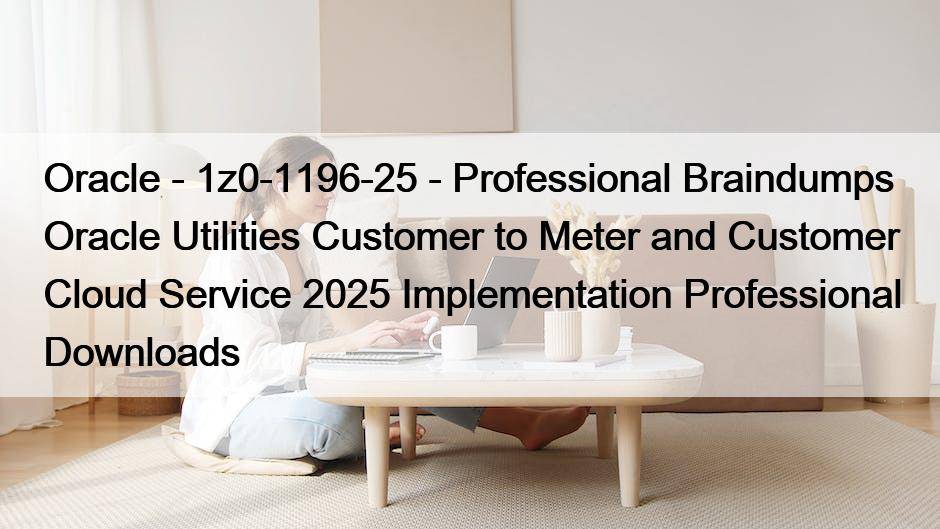Most Popular
 Free PDF Quiz Adobe - AD0-E605 - Adobe Real-Time CDP Business Practitioner Professional–Professional Guide Torrent
Free PDF Quiz Adobe - AD0-E605 - Adobe Real-Time CDP Business Practitioner Professional–Professional Guide Torrent
It is compatible with Windows computers and comes with a ...
 100% Pass Authoritative 300-715 - Implementing and Configuring Cisco Identity Services Engine New Dumps
100% Pass Authoritative 300-715 - Implementing and Configuring Cisco Identity Services Engine New Dumps
DOWNLOAD the newest UpdateDumps 300-715 PDF dumps from Cloud Storage ...
 Newest 1Z0-1123-25 Free Vce Dumps, Reliable 1Z0-1123-25 Exam Pattern
Newest 1Z0-1123-25 Free Vce Dumps, Reliable 1Z0-1123-25 Exam Pattern
We want to specify all details of various versions of ...



Oracle - 1z0-1196-25 - Professional Braindumps Oracle Utilities Customer to Meter and Customer Cloud Service 2025 Implementation Professional Downloads

We provide a wide range of learning and preparation methodologies to the customers for the 1z0-1196-25 complete training. After using the 1z0-1196-25 products, success would surely be the fate of customer because, self-evaluation, highlight of the mistakes, time management and sample question answers in comprehensive manner, are all the tools which are combined to provide best possible results. We are also offering 100% money back guarantee to the customers in case they don't achieve passing scores in the Oracle 1z0-1196-25 in the first attempt.
Oracle 1z0-1196-25 Exam Syllabus Topics:
| Topic | Details |
|---|---|
| Topic 1 |
|
| Topic 2 |
|
| Topic 3 |
|
| Topic 4 |
|
| Topic 5 |
|
| Topic 6 |
|
| Topic 7 |
|
| Topic 8 |
|
>> Braindumps 1z0-1196-25 Downloads <<
Key Features of PrepAwayETE's Oracle 1z0-1196-25 Exam Dumps
We've always put quality of our 1z0-1196-25 guide dumps on top priority. Each 1z0-1196-25 learning engine will go through strict inspection from many aspects such as the operation, compatibility test and so on. The quality inspection process is completely strict. The most professional experts of our company will check the 1z0-1196-25 study quiz and deal with the wrong parts. That is why we can survive in the market now. Our company is dedicated to carrying out the best quality 1z0-1196-25 study prep for you.
Oracle Utilities Customer to Meter and Customer Cloud Service 2025 Implementation Professional Sample Questions (Q38-Q43):
NEW QUESTION # 38
Which two statements correctly describe important concepts about service points?
- A. A service point's status indicates if the installed device is turned off.
- B. A premise may have zero, one, or more service points linked to it.
- C. A service point may have one or more metered devices installed at the same time.
- D. One service point exists for a property where multiple metered services are delivered.
- E. Over time, different metered devices may be installed at a service point.
Answer: B,E
Explanation:
Comprehensive and Detailed Explanation From Exact Extract:
In Oracle Utilities Customer to Meter, aservice pointrepresents a location where a utility service is delivered, such as a meter installation point. The Oracle Utilities Customer to Meter Configuration Guide explains:
Statement A: "Over time, different metered devices may be installed at a service point." This is correct, as service points can have different devices (e.g., meters) installed or replaced over time due to upgrades or maintenance.
Statement B: "A premise may have zero, one, or more service points linked to it." This is also correct, as a premise (e.g., a property) can have multiple service points for different services (e.g., electric, water) or none if no services are active.
The other statements are incorrect:
Statement C: A service point's status indicates its operational state (e.g., active, inactive), not specifically whether the installed device is turned off.
Statement D: A service point typically has one metered device installed at a time, though multiple measuring components may be associated with that device.
Statement E: Multiple service points can exist for a property with multiple metered services, not just one service point.
Thus, the correct answers areAandB, reflecting the system's service point management.
Reference:
Oracle Utilities Customer to Meter Configuration Guide, Section: Service Point Management Oracle Utilities Customer to Meter Implementation Guide, Chapter: Device and Service Point Configuration
NEW QUESTION # 39
Asset types define the attributes for assets and components of a certain type, including a variety of other information. Which two pieces of information may be included on asset types not considered as a class of components?
- A. List of location types where assets of this type can be located
- B. Whether or not assets of this type can have attached components
- C. List of types of asset activities that can be created for assets of this type
- D. List of types of components that can be attached to assets of this type
- E. List of specifications that can be attached to assets of this type
Answer: B,D
Explanation:
Comprehensive and Detailed Explanation From Exact Extract:
In Oracle Utilities Customer to Meter,asset typesdefine the characteristics and attributes of assets (e.g., meters, transformers) and their components. The Oracle Utilities Customer to Meter Configuration Guide explains that asset types not considered as a class of components (i.e., primary assets rather than sub- components) can include:
Statement A: "List of types of components that can be attached to assets of this type." This is correct, as asset types specify which component types (e.g., registers, communication modules) can be attached to the asset.
Statement C: "Whether or not assets of this type can have attached components." This is also correct, as the asset type configuration indicates whether the asset can support attached components.
The other statements are incorrect:
Statement B: The list of location types is typically associated with service points or premises, not asset types.
Statement D: Specifications are defined separately and linked to assets, not listed directly in the asset type configuration.
Statement E: Asset activities are managed through activity types and are not a direct attribute of asset types.
Thus, the correct answers areAandC, as they accurately reflect the configuration options for asset types.
Reference:
Oracle Utilities Customer to Meter Configuration Guide, Section: Asset Type Configuration Oracle Utilities Customer to Meter Implementation Guide, Chapter: Asset Management
NEW QUESTION # 40
Where can a business user configure what zones are to be displayed for them in Control Central/Customer
360?
- A. User - Portal Preferences tab
- B. Zone - Portal tab
- C. User - Main tab
- D. Portal - Zone tab
Answer: A
Explanation:
Comprehensive and Detailed Explanation From Exact Extract:
In Oracle Utilities Customer to Meter,Control Central(also referred to as Customer 360) is a centralized dashboard that displays customer and device-related information in configurablezones(e.g., account summary, service points, billing history). The Oracle Utilities Customer to Meter Configuration Guide specifies that a business user can configure which zones are displayed in Control Central via theUser - Portal Preferences tab. This tab allows users to personalize their view by selecting, arranging, or hiding zones based on their role and preferences, enhancing productivity and usability.
TheUser - Portal Preferences tabprovides a user-specific configuration interface where individuals can customize the layout and content of portals like Control Central. For example, a customer service representative might choose to display zones for account details, recent bills, and service points, while hiding zones for technical device data that are less relevant to their tasks.
The Oracle Utilities Customer to Meter User Guide further explains that this personalization is stored at the user level, ensuring that each user's Control Central view is tailored to their needs without affecting other users. This is particularly valuable in utilities with diverse roles, where different users require access to different types of information.
The other options are incorrect:
Option B: Portal - Zone tab.This is incorrect, as the Portal - Zone tab is used to define the zones available in a portal, not to configure user-specific displays.
Option C: Zone - Portal tab.This is incorrect, as it reverses the relationship; zones are linked to portals, but this is a system-level configuration, not user-specific.
Option D: User - Main tab.This is incorrect, as the User - Main tab contains general user information (e.g., name, role) but does not manage portal preferences.
Practical Example:A billing specialist configures their Control Central view in the User - Portal Preferences tab to display zones for "Account Balance," "Recent Payments," and "Bill History," while hiding the "Device Technical Details" zone. This customized view allows the specialist to quickly access billing-related information when assisting customers, improving response times.
The Oracle Utilities Customer to Meter Implementation Guide underscores that user-configurable zones in Control Central enhance the system's usability, enabling utilities to support diverse workflows while maintaining a consistent data access framework.
Reference:
Oracle Utilities Customer to Meter Configuration Guide, Section: User Portal Preferences Configuration Oracle Utilities Customer to Meter User Guide, Section: Customizing Control Central Oracle Utilities Customer to Meter Implementation Guide, Chapter: User Interface Customization
NEW QUESTION # 41
An issue is detected in a frozen bill segment prior to a bill being completed and sent out. If the frozen bill segment is then cancelled and rebilled, which two statements are correct after the bill has been completed?
- A. The bill will include both the original bill segment that was cancelled and the new billsegment details for the customer to see.
- B. Both the originating and cancellation financial transactions are swept onto the same bill and the Show on Bill switches on the financial transactions will be selected.
- C. The bill will only include the newly created bill segment details for the customer to see and the cancelled bill segment details will be suppressed from all subsequent bills.
- D. The bill will only include the newly created bill segment details for the customer to see and the cancelled bill segment details will be included in the following bill.
- E. Both the originating and cancellation financial transactions are swept onto the same bill and the Show on Bill switches on the financial transactions will be deselected.
Answer: C,E
Explanation:
Comprehensive and Detailed Explanation From Exact Extract:
In Oracle Utilities Customer to Meter, when a frozen bill segment is cancelled and rebilled due to an issue, the system handles the financial transactions and bill presentation as follows:
Statement A: "Both the originating and cancellation financial transactions are swept onto the same bill and the Show on Bill switches on the financial transactions will be deselected." This is correct.
According to the Oracle Utilities Customer to Meter Billing Guide, when a bill segment is cancelled, both the original (originating) and cancellation financial transactions are included in the bill, but their
"Show on Bill" switches are deselected to prevent them from appearing as line items on the customer's bill, ensuring clarity.
Statement C: "The bill will only include the newly created bill segment details for the customer to see and the cancelled bill segment details will be suppressed from all subsequent bills." This is also correct.
The documentation specifies that after cancellation, only the new (rebilled) bill segment is visible to the customer, and the cancelled bill segment is suppressed to avoid confusion.
The other statements are incorrect:
Statement B: Including both the original and new bill segments for the customer to see would create confusion and is not standard practice in the system.
Statement D: The cancelled bill segment details are not included in the following bill; they are suppressed entirely after cancellation.
Statement E: The "Show on Bill" switches are deselected, not selected, to ensure the cancelled transactions do not appear on the bill.
Thus, the correct answers areAandC, as they accurately reflect the system's handling of cancelled and rebilled segments.
Reference:
Oracle Utilities Customer to Meter Billing Guide, Section: Bill Segment Cancellation and Rebilling Oracle Utilities Customer to Meter Implementation Guide, Chapter: Billing Processes
NEW QUESTION # 42
Measuring components are single points for which data will be received and stored in the system. Measuring components are either subtractive or consumptive. Which statement is correct?
- A. Subtractive measuring components are associated only with water service, whereas consumptive measuring components are for gas and electric services.
- B. Subtractive measuring components are associated with deductive meters, whereas consumptive measuring components are not.
- C. A subtractive measuring component's usage is equal to the current reading minus the previous reading.
A consumptive measuring component's usage is equal to its current measurement. - D. Subtractive measuring components are used to measure demand, whereas consumptive measuring components are used to measure how much was consumed since the previous reading.
Answer: C
Explanation:
Comprehensive and Detailed Explanation From Exact Extract:
In Oracle Utilities Customer to Meter,measuring componentsare defined as points that capture and store measurement data, such as meter readings. Measuring components are categorized as eithersubtractiveor consumptive, based on how usage is calculated. The Oracle Utilities Customer to Meter documentation clarifies that:
Asubtractive measuring componentcalculates usage by subtracting the previous reading from the current reading. This is typical for meters that accumulate readings over time, such as water or electric meters.
Aconsumptive measuring componentcalculates usage based on the current measurement alone, without reference to a previous reading. This is common for devices that measure instantaneous or direct consumption, such as certain gas meters.
Option A accurately describes these definitions, making it the correct answer. The other options are incorrect:
Option Bis incorrect because subtractive and consumptive measuring components are not restricted to specific service types (e.g., water, gas, or electric). Both types can apply across various services depending on the meter configuration.
Option Cis incorrect because subtractive components measure consumption (not demand), and consumptive components do not necessarily measure consumption since the previous reading but rather the current measurement.
Option Dis incorrect because the term "deductive meters" is not used in Oracle Utilities documentation, and the distinction between subtractive and consumptive components is based on calculation logic, not meter types.
Reference:
Oracle Utilities Customer to Meter Configuration Guide, Section: Measuring Components Oracle Utilities Customer to Meter Implementation Guide, Chapter: Device and Measurement Configuration
NEW QUESTION # 43
......
Of course, when you are seeking for exam materials, it is certain that you will find many different materials. However, through investigation or personal experience, you will find PrepAwayETE questions and answers are the best ones for your need. The candidates have not enough time to prepare the exam, while PrepAwayETE certification training materials are to develop to solve the problem. So, it can save much time for us. What's more important, 100% guarantee to pass Oracle 1z0-1196-25 Exam at the first attempt. In addition, PrepAwayETE exam dumps will be updated at any time. If exam outline and the content change, PrepAwayETE can provide you with the latest information.
Dumps 1z0-1196-25 Reviews: https://www.prepawayete.com/Oracle/1z0-1196-25-practice-exam-dumps.html
- Valid Braindumps 1z0-1196-25 Downloads Help You to Get Acquainted with Real 1z0-1196-25 Exam Simulation 🧕 Download ( 1z0-1196-25 ) for free by simply entering ➠ www.prep4pass.com 🠰 website 🍉1z0-1196-25 New Exam Braindumps
- Practical Braindumps 1z0-1196-25 Downloads | Amazing Pass Rate For 1z0-1196-25 Exam | Valid 1z0-1196-25: Oracle Utilities Customer to Meter and Customer Cloud Service 2025 Implementation Professional 🎩 Easily obtain free download of ➤ 1z0-1196-25 ⮘ by searching on ➽ www.pdfvce.com 🢪 🏖1z0-1196-25 Valid Real Test
- Desktop Practice Oracle 1z0-1196-25 Exam Software - No Internet Required 🔂 Search for ➡ 1z0-1196-25 ️⬅️ and obtain a free download on ⏩ www.testsimulate.com ⏪ 🥪Reliable 1z0-1196-25 Exam Blueprint
- Braindumps 1z0-1196-25 Downloads | Perfect Oracle Utilities Customer to Meter and Customer Cloud Service 2025 Implementation Professional 100% Free Dumps Reviews 🦃 Go to website ➽ www.pdfvce.com 🢪 open and search for ➤ 1z0-1196-25 ⮘ to download for free 📏1z0-1196-25 Valid Test Testking
- Free PDF 2025 Oracle Reliable Braindumps 1z0-1196-25 Downloads 🍦 Download ⮆ 1z0-1196-25 ⮄ for free by simply entering ➽ www.dumps4pdf.com 🢪 website 📹Pdf 1z0-1196-25 Torrent
- Free PDF 2025 Oracle Reliable Braindumps 1z0-1196-25 Downloads 🥅 Download ⇛ 1z0-1196-25 ⇚ for free by simply searching on ➥ www.pdfvce.com 🡄 🤮1z0-1196-25 Trustworthy Source
- 1z0-1196-25 Latest Test Cram 🍳 Test 1z0-1196-25 Simulator 🏅 1z0-1196-25 Valid Test Testking 🧔 Download [ 1z0-1196-25 ] for free by simply searching on ➥ www.actual4labs.com 🡄 🥜Test 1z0-1196-25 Simulator
- Exam 1z0-1196-25 Revision Plan 🦰 Top 1z0-1196-25 Questions 🍕 1z0-1196-25 New Exam Braindumps 🔰 Open website ▛ www.pdfvce.com ▟ and search for ➡ 1z0-1196-25 ️⬅️ for free download 🗯Pdf 1z0-1196-25 Braindumps
- Braindumps 1z0-1196-25 Downloads | Perfect Oracle Utilities Customer to Meter and Customer Cloud Service 2025 Implementation Professional 100% Free Dumps Reviews 🏨 Enter ⏩ www.exam4pdf.com ⏪ and search for ➤ 1z0-1196-25 ⮘ to download for free 🌿1z0-1196-25 Online Version
- Valid Braindumps 1z0-1196-25 Downloads Help You to Get Acquainted with Real 1z0-1196-25 Exam Simulation 🔔 Copy URL 【 www.pdfvce.com 】 open and search for ➤ 1z0-1196-25 ⮘ to download for free 🤬Reliable 1z0-1196-25 Exam Blueprint
- Valid Braindumps 1z0-1196-25 Downloads Help You to Get Acquainted with Real 1z0-1196-25 Exam Simulation 🖋 《 www.pass4test.com 》 is best website to obtain ☀ 1z0-1196-25 ️☀️ for free download 🛶Test 1z0-1196-25 Simulator
- 1z0-1196-25 Exam Questions
- chems-hub.com www.lms.webcivic.com academy-climax.com quranpaktutor.com prathamai.com onlyphysics.in tishitu.net rashmimandal.com academy.nuzm.ee asijohn.net
Tags: Braindumps 1z0-1196-25 Downloads, Dumps 1z0-1196-25 Reviews, New 1z0-1196-25 Exam Questions, 1z0-1196-25 Dump, High 1z0-1196-25 Passing Score